My Son Was the Shooter
Seventeen years after Columbine, Sue Klebold is standing up for mental health awareness.

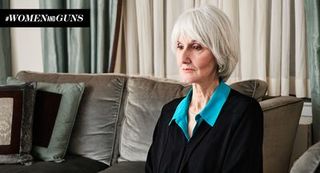
This story is a follow-up to MarieClaire.com's special report Women and Guns: The Conflicted, Dangerous, and Empowering Truth. Stay tuned this week as we publish Women and Guns response pieces and new material that sheds light on the nuanced world of females and firearms. Join the conversation on social media with the hashtag #WomenAndGuns.
As dozens of students were rushed out of Columbine High School on April 20, 1999, Sue Klebold got a call at her office in downtown Denver. "Susan, this is an emergency," her husband Tom said. "Gunman…shooter…school." Their son Dylan's best friend Nate had called Tom saying that he couldn't find Dylan or his friend Eric Harris. There were reports that shooters, still inside Columbine High School, had on black trench coats, like the ones Dylan and Eric often wore. Frantic, Klebold drove the 26 miles home, talking to herself as she sobbed. Tom tore apart the house, hoping that if he could find Dylan's coat, it would mean their son wasn't involved.
The coat wasn't there.
Dylan and Eric killed 13 people and injured 24 that day before turning their guns on themselves.
Nearly 17 years later, in a Manhattan hotel room, that same horrific scene of students shuffling out of the school with their hands behind their heads plays on the TV. Klebold, who has been casually watching the screen, sharply turns away from it when the grainy footage comes on and a voiceover refers to "Columbine: one of the most tragic school shootings in history."
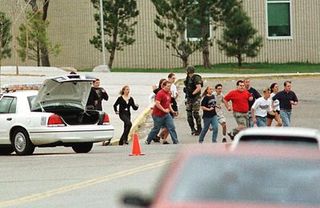
Columbine High School on April 20, 1999.
"It still shakes me," she tells MarieClaire.com as she looks down at her hands folded in her lap. "But I've come a long way. Fifteen years ago, that would have sent me into a panic attack."
Klebold's memoir, A Mother's Reckoning, is out this week, and she sat for her first-ever TV interview with Diane Sawyer, which aired Friday night. She says she's coming forward now, giving up her anonymity, in hopes that her story will help other people who have or know someone struggling with mental illness.
Stay In The Know
Get exclusive access to fashion and beauty trends, hot-off-the-press celebrity news, and more.
"It has taken a lot of courage. I've had to overcome a lot of fear to be able to do this, and it has not been easy. I try to keep focusing on the larger good that I'm trying to accomplish, which is to raise awareness and using the book to raise funds for research and suicide prevention and mental-health programs," says the 66 year old, who is donating 100 percent of her profits from the book to mental-health research. "I felt that I had some things to say that might be beneficial for people to hear, might make their loved ones safer."
At the time, Columbine was the deadliest school shooting in history. The attack drew worldwide attention, sparked a string of copycats, and changed the way law enforcement deals with shootings on school campuses.
Dylan was never diagnosed with a mental illness when he was alive, but experts, like Dr. Peter Langman, who Klebold interviewed for her book, have studied his journals and video recordings posthumously and said that he was depressed and possibly had schizotypal personality disorder. Eric, who did go to therapy and was never diagnosed with mental illness during those sessions, is now believed to have had personality traits of a psychopath, writing extensively in his journals about wanting to kill and torture others.
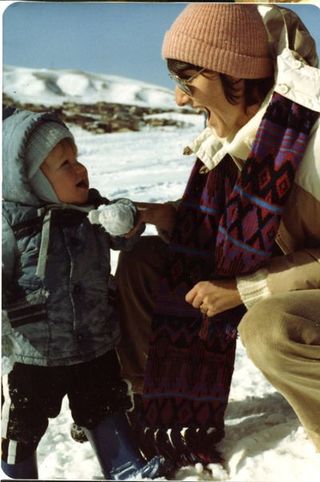
Sue Klebold with her son, Dylan.
It's just such a tragic irony that my husband and I were not gun enthusiasts.
The best friends spent a year planning the Columbine attacks, including designating where to place bombs, which never detonated because of miscalculations. They had a friend, Robyn Anderson, buy three firearms for them, because they were underage. And an older coworker at the pizzeria where they were employed bought the fourth gun used in the massacre.
In a recent study performed by MarieClaire.com and the Harvard Injury Control Research Center, 20 percent of women believe having a gun in the home makes them safer. Klebold was not one of those women. On April 20th, one of Klebold's first thoughts was that maybe the news of the shootings was a misunderstanding, a prank gone wrong, because there was no way her son could've possessed a real gun.
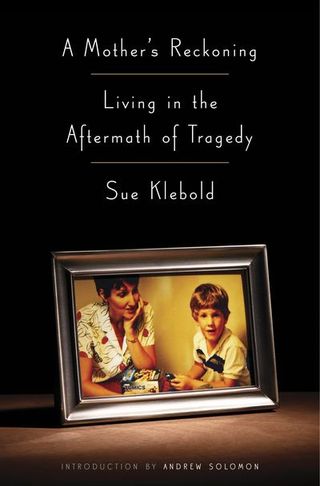
"It's just such a tragic irony that my husband and I were not gun enthusiasts. We didn't want them in our home or in our lives. But in my state of Colorado, a lot of people have guns, certainly in my own rural neighborhood, everyone had guns," she says. "And they were talking about, I don't remember which law it was at the time, but we felt that it would be very unsafe to live in a place that made guns that easy to carry around. And we were actually beginning to look at property in other states, because we didn't think that would be a safe way to live, which is incredibly ironic to think what happened."
Because of the prevalence of firearms in their community, Klebold didn't think twice when her teenage son asked for a gun for Christmas or when a gun catalogue showed up in a stack of junk mail. "If I had thought that was a sign, that he intended to use it, I would have had him getting help so fast that we would've been gone. It didn't seem that unusual for me," she says. "Because so many people we know hunt and they go to shooting ranges and firearms are widely used for recreational purposes, it just seemed like one of those things a kid would ask for, like a muscle car or gliding lessons. It was like, no you're not getting that. Don't even think about it."
In the aftermath of the attacks, the Klebolds and the Harrises kept quiet. (The Harrises have still never spoken publicly.) Sue describes both she and her husband meeting with their lawyer the night of the shootings in the darkness of a convenience store parking lot, fearful for their own safety. There were lawsuits against their families within days. And the media immediately began questioning their parenting. How could they have missed something so huge?
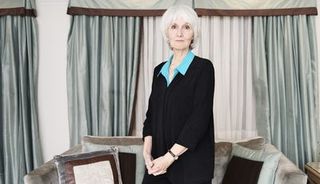
Sue Klebold, photographed on February 12, 2016, at the Michelangelo in New York City.
Klebold says now that there are dots that she wishes she'd connected that indicated her son's depression. In their junior year, Dylan and Eric were arrested for breaking into a van, which Klebold says did pique her concern, but that he seemed to straighten himself out.
"I really starting searching Dylan's room really diligently after his arrest, because he had gotten into trouble and I was watching to see if he stole something, could he have stolen something else? What else could he be doing?" she says. "But he was demonstrating to me that he was past this and he was handling his life. By the time he was a senior, he'd been accepted at four colleges. You come to a point that you trust that your children have come to a threshold of adulthood and there's not really much else you need to do in that regard. But I was wrong."
In writing her memoir, Klebold went through her old journal entries from before and after the shooting. Many of her writings in the weeks leading up to the attack paint the picture of an ordinary, happy family. In an entry dated April 1999, she writes:
We all focused on Dylan to get him ready for the prom. It was so cute. A. came over and we took pictures. Robyn & he left at around 6, and he has a big night ahead.
When Dylan got home late that night, he told his mom he'd had the best night of his life. The shootings took place just two days later.
A week before his suicide, Dylan was mapping out the dorm room he'd be moving into at Arizona State University and putting on a happy face for family dinners. But in his journals, which his family didn't see until months after the shootings, he was contemplating suicide, writing about cutting himself and contemplating "going NBK," which stands for Natural Born Killers, the name of the Oliver Stone movie which he and Eric used as the codename for the attacks.
Klebold says she hopes the conflicting images of her son "helps [others] be more aware that people around them may be suffering, they may have despair, they may feel helpless and hopeless, but they may be working very hard to present that everything is fine," says Klebold, who has focused on suicide prevention in the wake of Columbine. (According to the American Association of Suicidology, between two and five percent of suicides are murder-suicides.)
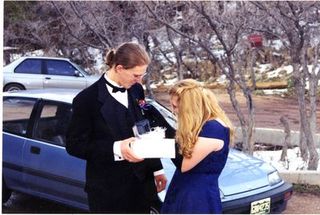
Dylan Klebold with his prom date, Robyn Anderson.
In the years since Columbine, there have been 50 mass shootings at schools, according to the FBI, which Klebold says used to "reintroduce trauma for me." But now: "I can't say that anymore they are. I just have a sense of being aware of the horrible ordeal that everyone affected by this tragedy is going to be going through. And I just feel compassion for the people who have been injured, who have been killed, and also for the families of the perpetrators. I know they're about to embark on a very difficult journey, as well."
Klebold wrote letters of apology to his victims' families, as well as to the survivors.
Klebold says she never reaches out to families of victims or perpetrators but that she's made herself available through therapists or friends of friends and that she has met some of the families of other shooters. (She won't name which ones, in order to protect their privacy.)
After her own son's shooting, Klebold wrote letters of apology to his victims' families, as well as to the survivors. One of those letters resurfaced last week. Upon hearing news of Klebold's book and 20/20 interview, Anne Marie Hochhalter, a senior at Columbine who was paralyzed in the attack, posted this message on Facebook:
Posted by anne.hochhalter on
"I heard about that today. It was amazing," Klebold says. "When I heard about it, I cried so hard. It was so impactful to me. I was so grateful. I was overwhelmed."
Not all of the reaction to Klebold coming forward has been so positive, including tweets from the Colorado Attorney General calling the 20/20 interview "irresponsible" and "inflammatory."
Though Klebold still lives in Colorado, she says she's never run into any of the survivors of victims' families—that she knows of.
"I don't think we really know what each other looks like now after 17 years," she says."I always live in fear of being recognized or being in a doctor's office. You don't want them to go, 'Mrs. Klebold!' I'm always concerned about who may know I am because I never know if someone near me is a family member of one of the people who were hurt or killed."
Klebold says she's considered moving and changing her last name, but so far, has always opted not to.
"Many times. I still might do it, but I'd have to have a good reason," she says. "I realize that I really can't run from this. I can change my name, I can move, but I still have to live with the fact that my son killed other people."
I realize that I really can't run from this. I can change my name, I can move, but I still have to live with the fact that my son killed other people.
Today, the former community college counselor is retired. She and Tom divorced in 2014. She says the way they grieved drove them apart. Like the families of most mass shooters, Tom and their older son Byrone have chosen not to step forward to talk about Columbine. Klebold says she prefers to not speak publicly about them.
"I live a very small, purpose-driven life. I still do volunteer work around suicide prevention. I'm on some boards and committees," she says. "And I try to be really kind to myself. I put things into my life that I enjoy doing. Yoga, Zumba, art, nature, walking, being with people that I love. I try to really focus very hard on a sense of gratitude. I really work hard to go to bed at night counting blessings. And try to remember that there are so many things to be thankful for. Even little things like having hot water come out of your sink or having someone smile at you. These are little things but they're gifts. Every one of them is a gift."
This story is a follow-up to MarieClaire.com's special report Women and Guns: The Conflicted, Dangerous, and Empowering Truth. Stay tuned this week as we publish Women and Guns response pieces and new material that sheds light on the nuanced world of females and firearms. Join the conversation on social media with the hashtag #WomenAndGuns.
Kate Storey is a contributing editor at Marie Claire and writer-at-large at Esquire magazine, where she covers culture and politics. Kate's writing has appeared in ELLE, Harper's BAZAAR, Town & Country, and Cosmopolitan, and her first book comes out in summer 2023.
-
 Selena Gomez Does Dark Academia in a Goth-Glam Gown
Selena Gomez Does Dark Academia in a Goth-Glam GownThe star shimmered in a beaded gown with a crisp white collar and heaps of diamond jewelry.
By Hanna Lustig Published
-
 Make This Winter’s Denim Trends Work for You
Make This Winter’s Denim Trends Work for YouFrom wide-leg to barrel jeans, this season celebrates versatility and individual style.
By Emma Childs Published
-
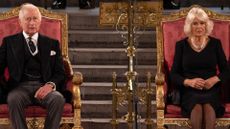 Queen Camilla and King Charles Announce the Death of a Beloved Family Member
Queen Camilla and King Charles Announce the Death of a Beloved Family MemberRest in peace.
By Kristin Contino Published
-
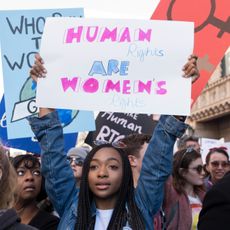 36 Ways Women Still Aren't Equal to Men
36 Ways Women Still Aren't Equal to MenIt's just one of the many ways women still aren't equal to men.
By Brooke Knappenberger Last updated
-
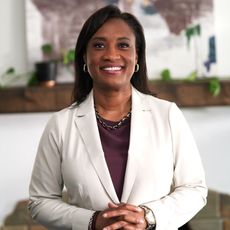 EMILY's List President Laphonza Butler Has Big Plans for the Organization
EMILY's List President Laphonza Butler Has Big Plans for the OrganizationUnder Butler's leadership, the largest resource for women in politics aims to expand Black political power and become more accessible for candidates across the nation.
By Rachel Epstein Published
-
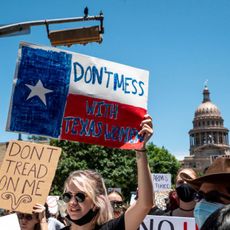 Want to Fight for Abortion Rights in Texas? Raise Your Voice to State Legislators
Want to Fight for Abortion Rights in Texas? Raise Your Voice to State LegislatorsEmily Cain, executive director of EMILY's List and and former Minority Leader in Maine, says that to stop the assault on reproductive rights, we need to start demanding more from our state legislatures.
By Emily Cain Published
-
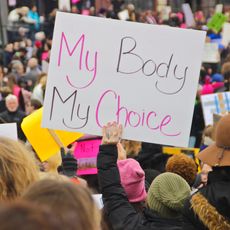 Your Abortion Questions, Answered
Your Abortion Questions, AnsweredHere, MC debunks common abortion myths you may be increasingly hearing since Texas' near-total abortion ban went into effect.
By Rachel Epstein Published
-
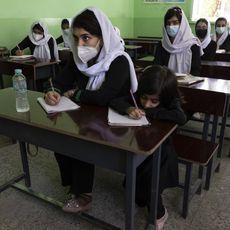 The Future of Afghan Women and Girls Depends on What We Do Next
The Future of Afghan Women and Girls Depends on What We Do NextBetween the U.S. occupation and the Taliban, supporting resettlement for Afghan women and vulnerable individuals is long overdue.
By Rona Akbari Published
-
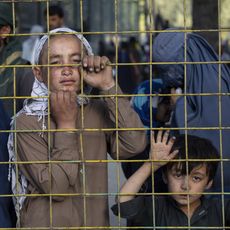 How to Help Afghanistan Refugees and Those Who Need Aid
How to Help Afghanistan Refugees and Those Who Need AidWith the situation rapidly evolving, organizations are desperate for help.
By Katherine J. Igoe Published
-
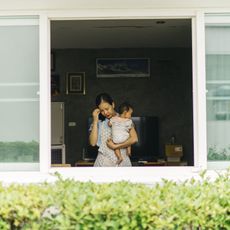 It’s Time to Give Domestic Workers the Protections They Deserve
It’s Time to Give Domestic Workers the Protections They DeserveThe National Domestic Workers Bill of Rights, reintroduced today, would establish a new set of standards for the people who work in our homes and take a vital step towards racial and gender equity.
By Ai-jen Poo Published
-
 The Biden Administration Announced It Will Remove the Hyde Amendment
The Biden Administration Announced It Will Remove the Hyde AmendmentThe pledge was just one of many gender equity commitments made by the administration, including the creation of the first U.S. National Action Plan on Gender-Based Violence.
By Megan DiTrolio Published